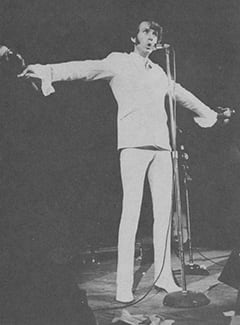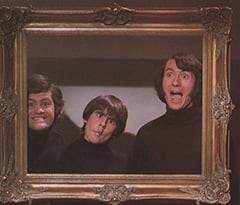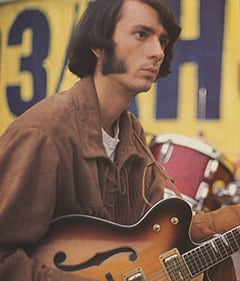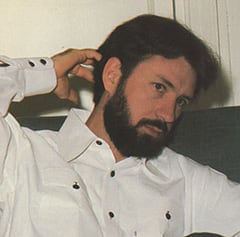
(The following interview with Mike Nesmith was conducted by writer Mike McDowell in Carmel, California on June 21, 1978. McDowell is the publisher/editor of Blitz magazine, and this interview originally appeared in the October ’78 issue of that publication. Strangely enough, the interview hasn’t dated that much over the years, and it’s one of the few places during the last decade that Nesmith has discussed his musical career and time spent with the Monkees.—Ed.)
Meeting Michael Nesmith for the first time was the realization of a 12-year-long dream. Nesmith’s work has demonstrated the highest caliber of aesthetic enrichment and emotional fulfillment. Be it his early singles for Omnibus, Edan and Colpix Records, his pioneering groundwork as lead guitarist with the Monkees, or his country-rock innovations with the First National Band, the name Michael Nesmith has always stood for first-rate musicianship.
Today, Nesmith resides in Carmel, California, where he presides over the Pacific Arts Corporation, an up-and-coming multi-media service.
Mike McDowell: In order to gain a more accurate perspective on the musical developments in your career, I’d feel it’s more important to trace the various stages through your earliest recorded material. You had a single in 1963 on the Omnibus label as part of a trio called Mike, John and Bill. The record was considerably ahead of its time, displaying an almost folk-rock sound that would be popularized about two years later by the Byrds and the Turtles.
Mike Nesmith: It was a style that came naturally to me. I had been playing the club circuit at that time, and music in more of a folk vein was at its peak of popularity. The fusion of rock and folk wasn’t a conscious direction, it just happened as such. John and Bill on that record were John London and Bill Sleeper. John later played with me as a member of the First National Band. Anyway, we were discovered playing in a club by Frankie Laine’s girlfriend, who really liked the way we sounded. She recommended us to Frankie, who was starting his own label at the time. Consequently, our record was released on his Omnibus label.
There are several conflicting reports circulating as to your musical whereabouts in the year immediately following the Omnibus single. I’ve heard that you filled in as a member of the New Christy Minstrels for one tour and that you played with the country band Red Rhodes & The Detours on a live album they released at the time. Any truth to any of this?

Nesmith: I have never played with the New Christy Minstrels. I have no idea where that rumor got started! And although I had known Red Rhodes for some time prior to his joining the First National Band, I did not appear on his live album. I had been appearing both as a solo act and with other performers during that time.
In 1965, “Just A Little Love,” the song you composed for the B-side of the Omnibus single re-surfaced under just your own name, coupled with a garage band instrumental called “Curson Terrace,” which was credited to Mike and Tony. Who is Tony?
Nesmith: I’d like to know that one myself! I have no idea who Tony is. I never played with anyone named Tony. I was amazed when I found out that single had been released. It most definitely is me on there, but I have no idea who is behind the release of it.
Soon after, you released two singles under the name of Michael Blessing on Colpix. Both have slight overtones of Bob Dylan, yet show a gradual leaning towards country-rock, much as the type that surfaced on the debut Monkees album with “Papa Gene’s Blues.” A conscious influence at this point?
Nesmith: In a sense. As I said before, this type of music just came naturally to me. I don’t know if it has anything to do with the fact that I’m from Texas, but it just seemed right for me to play in this vein.
This of course brings us to the chronological point of your first days as guitarist with the Monkees. To be sure, the frantic pace of the demanding, schedule must have been a considerable strain. As I understand, as soon as Pete, Micky, David and yourself found that you would be playing together, you had made some preliminary demo tapes for eventual release. Can you elaborate on some of this material?
Nesmith: When we first found out that we were going to be the Monkees, we called a meeting to show each other what ideas we had and find out what directions we wanted to take. Pete had been working as a folk singer in clubs and did some session guitar work for the Mamas & Papas. Micky was in a band called the Missing Links, and David had an album out already at the time. We discussed our musical interests for awhile and figured we had better get some new equipment to practice on. We piled up in a truck and drove to a music store and bought about $5000 worth of new equipment. We went into a studio and cut some rehearsal tracks.
As I understand, you recorded almost one hundred tracks at this time, all of which were done before you ever filmed the first episode of the Monkees’ television show. Are there plans for any of this material to surface?
Nesmith: I can’t give you a specific figure on how many tracks we laid down, but a hundred seems like a pretty accurate estimate. We recorded those in the studios at Columbia before the whole television thing started. Of course, at the time, we had no idea what was going to happen with the series. We were just a fun band. We enjoyed playing together and didn’t realize what the situation would develop into with the exposure from the show. What we cut was actually just some rehearsal tapes. We were really as much of a garage band as you could hope for! In fact we sounded a lot like Question Mark & The Mysterians. If you really want to know what we sounded like at that time, one of the tracks from that period actually did get released as the B-side of a single. It was the track “The Girl I Knew Somewhere,” a song I wrote that appeared as the flip side of “A Little Bit Me, A Little Bit You.” We cut that song at those early sessions in the Columbia studio with me on lead guitar, Pete on bass and overdubbed keyboards and Micky on the drums. This was the type of sound I wanted the Monkees to pursue at the time. Some time later, we were asked to come into the studio to cut the first Monkees album. We brought the tapes with us that we cut at Columbia and played them for Don Kirshner, who had been chosen to head the Colgems label. He listened and seemed to like what he heard, but also said that this was not at all the musical directions that he had intended for the Monkees. And you know the rest of the story. It soon became apparent to me that I would not be satisfied playing in that context for very long.
But what stands as a tribute to the Monkees’ musical integrity is the fact that you refused to allow youself [sic] to be dictated to or manipulated by a record label. In retrospect, the Monkees really set the precedent for self-control within a rock band by demanding an uncompromising voice for themselves with respect to their musical directions. In fact, one can detect a great deal of symbolism to that effect with the cover of the Monkees’ Headquarters album, which was the first album the Monkees cut without intervention from Kirshner.
Nesmith: How would you interpret the cover of that album?
As kind of a freedom from restraint. The cover depicts the four of you joining hands in a sort of football huddle as if to say that we’re putting our heads together and this is all ours. The idea is reinforced by the fact that you’re all smiling as if having been rid of a nemesis. And the fact that you’re standing amidst a pure white backdrop indicates you’re starting all over again without the unfortunate circumstances that plagued the first two albums. This attitude seems to carry on to the record itself. For an example, the first song on side one, “You Told Me,” has all of you counting out the tempo frantically and taking deep breaths as if you’re ready to burst forth for the first time with all the musical freedom you could possibly hope for. The energy carries on through the album, which radiates a feel that you’re giving a supreme effort towards a project you feel very strongly about.
Nesmith: That’s quite an interpretation! I’ve never gone into that much detail with it, but I can accept that.
Are you aware that Headquarters was issued with two different back covers? Most copies have a picture at bottom center of Chip Douglas and Hank Cicalo sitting at the engineering board of the recording studio, but a limited number of pressings omit that picture in favor of a shot of Chip and Hank seated together surrounded by the Monkees with an apparently outrageous growth of hair and beards by 1967 standards.
Nesmith: I wasn’t aware of that. It never occurred to me to look at the cover for something different.

Anyway, it was soon after the release of Headquarters that the Monkees began their first American concert tour. To be sure, a lot of skeptics must have been converted to your cause at that time. I recall the energy level at your appearance at Olympia Stadium in Detroit as being very high.
Nesmith: It’s interesting that you should bring that up. I look at the Olympia stop as being one of the high points of that tour. We walked into Olympia the morning of the show, and I recall being amazed at the vast size of the building. I looked at the high ceilings and wondered how we would sound with acoustics like that. Someone told me that 20,000 people were coming and that was all I had to hear! We really played well that night.
Of course the Monkees’ own musical directions were progressing rapidly at the same time. I was always impressed by the way your lead guitar and Pete’s bass parts complemented each other on so many recordings. Pete has an unusual lick that starts half an octave above the key of the song. He bends the notes downwards to slide in to that key. This especially surfaces on “Pleasant Valley Sunday.” Unique thing about the lyrics there too, portraying your obvious dissatisfaction with the complacency of life in suburban America.
Nesmith: Yeah, I’ve always liked Pete’s bass playing. It worked well in concert when we traded licks in certain numbers. But I hate to pop your balloon about “Pleasant Valley Sunday.” That song was actually written about a mental institution.
That’s great! It adds to the list of numbers with double entendre lyrics you were experimenting with at the time, like “Salesman” for an example. Actually, the period involving Pisces, Aquarius, Capricorn & Jones, Ltd., The Birds, The Bees & The Monkees and Head shows the Monkees to have been progressing probably more than any other rock band at the time.
Nesmith: But don’t forget about the Beatles. You can’t deny that they were initiating a great deal of experimentation at the same time. Look at what they were doing in Magical Mystery Tour.
There was nothing in Magical Mystery Tour that hadn’t been done many times before in an experimental dadaist European film festivals since the 1940s. And the Beatles themselves admitted that much of their later material was recorded as a joke.
Nesmith: I prefer not to look at it as a competitive thing. I respect the Beatles for what they did, and I’m also proud of what I did with the Monkees.
Nonetheless, it’s obvious that the Head film is perhaps the greatest and most innovative experiment ever attempted by a rock band on film. Each time a person sees it, there are so many subtle symbolisms that surface, subjecting the film to even more detailed interpretations.
Nesmith: How would you interpret the Head film?
It’s apparent that the Monkees are trying to destroy the jaded image conceived around them by the ignorant mass media. You are obviously lashing out at the critics who unjustly slighted your efforts, as well as exaggerating the more ludicrous aspects of the ensuing culture of the times. A good example would be the scene in the factory, where the company boss tells you, “The tragedy of your times, my young friends, is that you may get exactly what you want;” an apparent reference to the countercultural movement growing at the time to express dissatisfaction with Lyndon Johnson’s escalation of American involvement in the Vietnam war.
Nesmith: It’s all that, and a lot more. We wanted to make a valid artistic statement that would document our growth as artists. I feel that we succeeded with Head.
I honestly regard the Monkees’ on-stage performance of “Circle Sky” in the Head film as the greatest live performance ever made by any rock band at any time. You can feel the intensity by the way Micky attacks his drums and by the way you and Pete build on each other’s licks; you with the bar chords on lead and Pete with his characteristic sliding bass riffs.
Nesmith: I really like “Circle Sky” a lot. If you ever get the chance, listen closely to the lyrics and try to figure them out. I realize they’re difficult to understand, but I think you’ll be very surprised when you finally get them.
After the Head film and album were completed, the directions the Monkees took with the albums Instant Replay and The Monkees Present seem puzzling at times. I get the impression that some of the tracks were either outtakes or unreleased material that had been sitting in the vaults for some time. In particular, “Tear Drop City” comes to mind, which is quite similar to “Last Train To Clarksville” of three years prior to that. Some of the material featuring you, such as “Don’t Wait For Me,” and “Never Tell A Woman Yes” even leans towards the country rock material that you were pioneering a year later with the First National Band. Was this a direction you were trying to lead the Monkees into?
Nesmith: Some of the tracks on both Instant Replay and The Monkees Present were left over from much earlier recording sessions, but the better part of the material was recorded for those albums. “Tear Drop City” was recorded by us during those pre-television series days at the Columbia studios. That was originally to have been our first single. But as far as my so-called pioneering work in country rock, I want to emphasize that such a position has never taken top priority in my mind. If you want to examine the real roots of country rock, you’ll have to look at the early recordings of Rick Nelson. As far back as 1961, he was developing modern country rock with songs like “Hello Mary Lou.” He’s really the man to take the credit for all that developed within the country rock idiom.
Agreed. Rick Nelson has probably done more for that musical genre than anyone other than yourself. But with Intakes, his most recent album, Rick stated that he is returning to his rock ’n’ roll roots.

Nesmith: That’s true. Intakes is such a phenomenal album! I admire the directions he’s taking and I think he’ll go a long way in that field. What I was doing with the Monkees at the time of the last two albums I appeared on was to try and move us in the direction of country rock. Of course, I had no intention of leaving the group at the time those albums were recorded, and I had long range goals for us in that respect.
Magnetic South was an astounding debut in that genre, though I get the impression that you were surprised at the success of “Joanne” as a single, since it was not the first single from the album.
Nesmith: Actually we wanted “Joanne” for the first single, but RCA issued “Little Red Rider”’ instead.
“Joanne” was a gold single, wasn’t it?
Nesmith: It should have been, but it wasn’t. I have some figures of sales reports from various distributors who say that the record sold 1.2 million copies. But RCA’s figures say that it only sold 325 thousand. So consequently we didn’t receive a gold record for it.
Dean Torrence of Jan and Dean did the cover for your Magnetic South album. How did this association come about?
Nesmith: I met Jan Berry through a friend of his that was a member of the therapy group Jan was participating in to help him recover from his automobile accident. It was through Jan that I met Dean.
It’s interesting to note some of the directions that your later albums took, such as And The Hits Just Keep On Comin’ and Pretty Much Your Standard Ranch Stash. These almost branch into free-form country, and ofttimes display a direction that is difficult to pinpoint.
Nesmith: That’s because they really weren’t country-oriented. Look at the first three albums, Magnetic South, Loose Salute and Nevada Fighter. These were part of a trilogy. Magnetic South was obviously very country in nature, Loose Salute was a bit less country and a bit more rock, and Nevada Fighter was almost all rock and no country. No matter what may have been said about what I’ve done with respect to country & western or country rock, I always was and always will be a rock ’n’ roller. My roots lie in rock ’n’ roll.
With that in mind, what do you think of some of the up and coming new wave performers that are leading a movement towards musical economics and solid rock ’n’ roll?
Nesmith: I’ve been reading the issues of Blitz you’ve been sending me, and a lot of these names are arousing my curiosity. Look at these names: $27 Snap-On Face, the Suicide Commandos, the Human Switchboard. I can’t quite put my finger on it, but I sense something there that I really like, and I’d love to become more involved with it. And what’s all of this I keep hearing about the Monkees becoming punk heroes?
It’s true! The Suicide Commandos do a version of “She” on their album. The Sex Pistols have performed “(I’m Not Your) Steppin’ Stone” onstage. A great number of the artists involved have cited the Monkees as a major influence.
Nesmith: That’s incredible!!
Whose records have you listened to lately?
Nesmith: I just picked up Bruce Springsteen’s new album and Bob Seger’s Stranger In Town. I’m really impressed with the Cars’ LP, as well. I just got Elvis Costello’s This Year’s Model, but I haven’t had the chance to get into it as much as I’d like to. I see you reviewed Micky and David’s soundtrack album of The Point in your magazine. What did you think of that album?
I liked David’s “Blanket For A Sail” and Micky’s “He’s Leaving Here This Morning” a lot, but the album seems to be restraining their talents a bit. I don’t know if they’re entirely happy in that musical context.
Nesmith: I think you’re being a bit generous to it. I didn’t like that album at all. I know those guys too well, and believe me, they’re capable of doing a lot better material than that.

Any future recording plans in the works yet?
Nesmith: I’m working on another studio album, which will tenatively [sic] be titled Infinite Rider On The Big Dogma. I haven’t recorded any of it yet, as I’m just putting the finishing touches on the songs themselves. It should be all original material, though I may include a cover of one of several songs I’m interested in.
And of course you’re keeping an eye open for new talent.
Nesmith: Like I said, I’d be interested in hearing people’s tapes. Speaking of new talent, I notice that in a review of an Elvis Costello show in your magazine, you compare his performance to the Monkees’ concert at Olympia. (Pauses) Do you think it would be an artistically viable prospect for the Monkees to get back together?
What an understatement!!!! I don’t see any reason for you not to. The unique thing about the Monkees is that you were able to combine four unique musical backgrounds into one cohesive sound by drawing upon the best element of all four genres. I hope you don’t feel any bitterness over the tremendous wrongs done to the Monkees and their musical image by Don Kirshner. It was definitely to your credit to stand up to him as you did, and I think the potential to reaffirm your greatness as a band is still evident in each of you.
Nesmith: This is really the last thing you’d expect to hear out of a guy like me, but whatever went down between Don Kirshner and myself at that time simply happened. Don is a corporate executive, and simply fulfilled that role. But look out the window of my office here. You’ll see incredibly beautiful surroundings. I live in a nice area, I’m a happily married man, I’ve got a growing media firm and all the artistic freedom I want. Actually, I’m just as happy as a clam!
In the event of a possible Monkees reunion, had you ever considered adding Chip Douglas on as a fifth member of the band? After all, not only was he your producer, but he was a first-rate musician, as well.
Nesmith: I think I know what you’re getting at, but the way I have always looked at the Monkees was a three-piece band with David as the front man. It’s hard for me to picture it in any other context.
So how do you view the prospects of the Monkees getting back together?
Nesmith: Well, it’s not likely that the four of us would come to terms on this situation, but this is the way I’d want it to happen. I’d have Micky, David and Pete come up here to Carmel and we’d go into the studio and do an album completely on our own, based upon a synthesis of our own musical directions. I’d put the album out on Pacific Arts. No hype, no full page ads in the trade papers saying “Monkees comback [sic] album!” or anything like that. I’d just quietly put the album out and let people discover it on its own musical merit. Under those circumstances, yeah, I’d do it.




